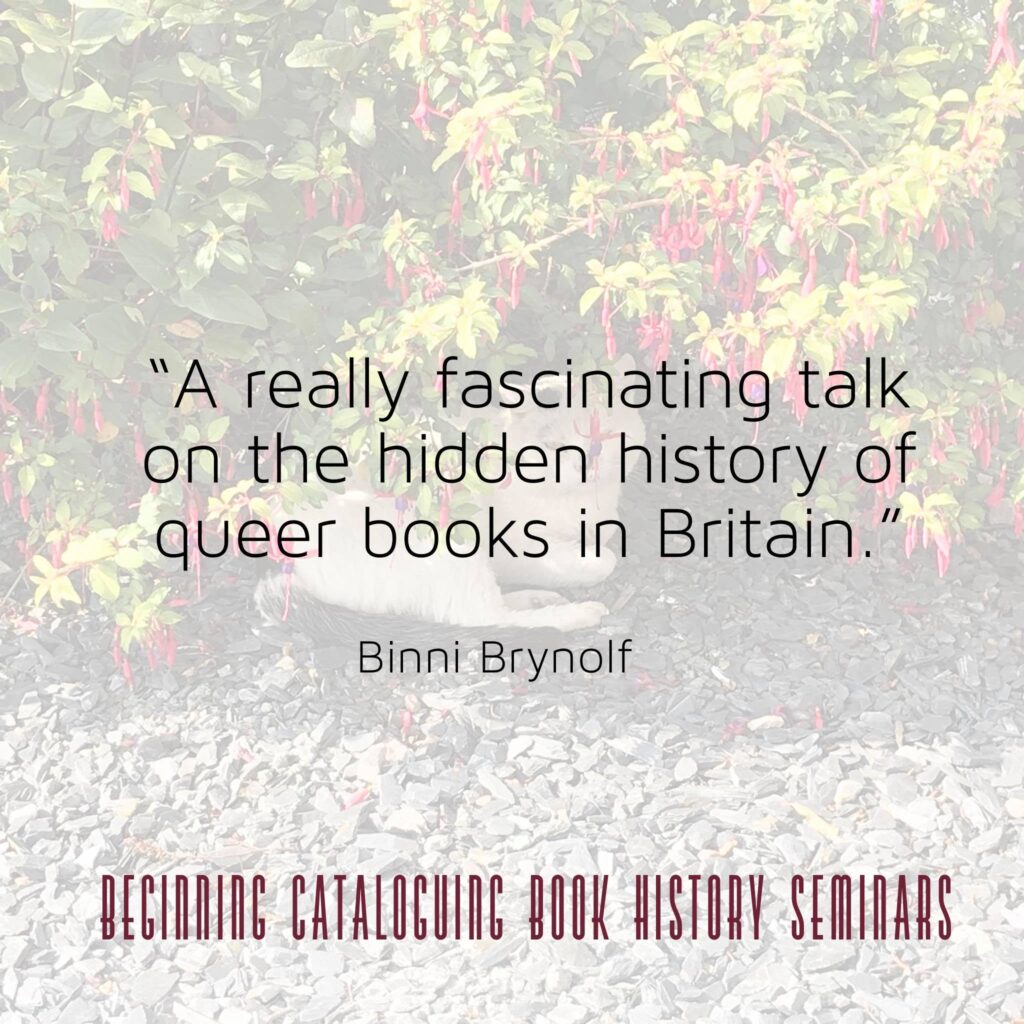
On 13 January, I attended the Book History Seminar on UK LGBTQ+ Publishing History.
The speaker was Christopher A. Adams, a writer, bibliographer, and doctoral student whose dissertation subject is British queer fiction publishing from 1945 to 1967 (when homosexuality was partially decriminalised in British legislation). This was a really fascinating talk on the hidden history of queer books in Britain. We were given lots of examples which were immediately added to my reading wish list, and we had ample opportunity to ask questions as well.
After World War II, the number of queer characters in British fiction rose, but dropped again in 1954 due to major obscenity cases. It increased again and reached a peak in 1962, after the trial of the publisher Penguin over the book Lady Chatterley’s Lover and the subsequent relaxation of English obscenity laws.
Queer books were published by all the major publishers of the time. What’s clear is that there were three times as many titles with male queer characters than with female queer characters, a probable consequence of English and Welsh law which criminalised male homosexuality but ignored female homosexuality, making it all but invisible. This may also be a consequence of the fact that British publishing was very much an old boys’ network so who were more interested in publishing books with characters resembling themselves i.e. upper class and male, such as Maurice by E. M. Forster.
One major factor that affected the publication of queer books included the English obscenity laws. Everyone involved in publication could be prosecuted – not just authors but also the publishers and printers. Christopher discussed the title The Man on the Rock by Francis King. There wasn’t any sexual activity between the men in the book and the publisher was happy to publish without editing the text in any substantive way, but the printer objected and refused to print the book until changes were made. Even when a publisher or editor were themselves queer, they had to consider how advocating for a queer text could affect them personally. It could bring suspicion upon them, and even cause them to lose their jobs.
British publishers relied on overseas markets for a third of their business but even when English obscenity laws were relaxed, legislation in other countries could affect the publication of queer titles. For example, The Youngest Director by Martyn Goff was published by Putnam in London in 1961 but was banned in Ireland where obscenity laws were stricter. Another consequence of the relaxation of the law in England meant that James Baldwin was able to get the novel Giovanni’s Room published in the UK ahead of the US, where it had been rejected by the publisher because it would have labelled Baldwin as a black and queer author, hurting sales and reflecting badly on them.
Christopher pointed out that obscenity laws in other media could also affect the publication of queer books; for example, film rights could be much more lucrative than book sales. It could be difficult for queer literature to travel to other media – there was more freedom in book publishing and less in film, theatre and radio.
Another factor was economic censorship: W.H. Smiths was the largest and most influential bookseller in the UK with access to a huge market but would be equally liable if a book was prosecuted for obscenity and as a result, they tended to be very cautious, especially when it came to queer titles. Not getting a book into W.H. Smiths’ shops and catalogues could have a huge, negative effect on book sales.
Social attitudes also affected the publishing of queer titles because of the potential negative reception. For example, Christopher shared a review of A Jingle-Jangle Song by Mariana Villa-Gilbert which was both misogynistic and homophobic.
At the end of the talk, participants posed questions such as ‘are there resources for finding hidden queer books and materials?’ – however, there aren’t really any specific resources. This research involves trawling through archives for any reference to queer titles. Hopefully work such as Christopher’s will help in the creation of such resources, so that the hidden queer works are no longer so hard to find.
Examples of queer books / queer authors mentioned in the presentation:
- An Air That Kills – Francis King (London: Home & Van Thal, 1948)
- The Man on the Rock – Francis King (London: Longman’s, Green & Co, 1957)
- The Youngest Director – Martyn Goff (London: Putnam, 1961)
- The Last of the Wine – Mary Renault (London: Longman’s, Green & Co, 1956)
- A Domestic Animal – Francis King (London: Longman’s, Green & Co, 1969)
- Giovanni’s Room – James Baldwin (London: Michael Joseph, 1957)
- The King Must Die – Mary Renault (New York: Pantheon, 1958)
- A Jingle-Jangle Song – Mariana Villa-Gilbert (London: Chatto & Windus, 1968)
- Myra Breckinridge – Gore Vidal (London: Anthony Blond, 1968)
Bibliographies:
- The Male Homosexual in Literature (Metuchen, NJ: Scarecrow Press, 1982)
- The Lesbian in Literature (Naiad Press, 1981)
Binni Brynolf
Note: We’ve used affiliate links in this post. You can find out more about how we use such links here.